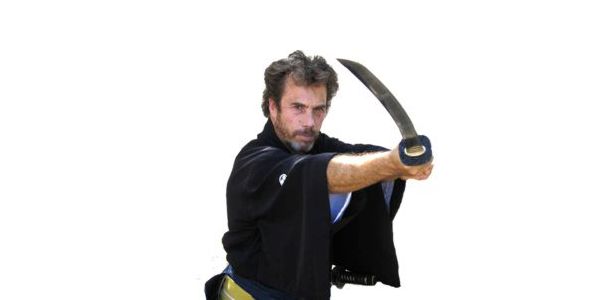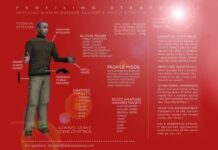In the following few paragraphs I want to explain the “nuts and bolts” and the “hows and wherefores” for the usage of the Japanese sword and its origin. Learning how to understand the rudiments of each weapon is of the utmost importance if you are ever going to learn, teach or wield a sword.
Whether the sword is constructed from wood, metal or bamboo all these weapons have one thing in common and that is… body and hand posturing. No matter what type of Japanese sword or training tool is placed into one’s hand they would instinctively know how to manipulate movements and techniques required for that particular scenario. This is called going “full circle”. The term going “full circle” is what an accomplished sword practitioner would call the point in their lives/ careers where they have finally perfected the execution and movements including the economy of motion theory. It is a commonly known fact that sword masters who study and teach would automatically reach for the wooden sword to hone theirs and other’s techniques.
The bokken or bokutou: wooden sword
The bokken is the ultimate learning tool. It allows one to understand practical sword technique, approach and execution safely due to the lack of sharp edges. It is easy to purchase or even construct for the adventurous as the materials are readily available. To the beginner, intermediate or advanced the bokken serves as a very practical learning tool. Merely grip the handle with one or two hands and begin practicing cutting patterns. Of course, it is much easier to speak of it than to do it. Many bokken seen today have a tsuba. A tsuba also called a hilt or hand guard is used on a sword for safety. Most blocks are executed toward the hilt or very close to the handle since the student has not developed the required hand eye coordination.
Beginners use a tsuba so as not to injure their hands and fingers when executing techniques such as tsuriage. With experience the student is able to deflect with the tip of their sword rather than blocking near the handle. Deflection allows the opponent’s strike to be repelled away from the body resulting in a better opportunity to attack or counter attack. This principle applies to all types of Japanese swords but is more readily seen and practiced with a bokken.
The shinai: bamboo sword
AKA a yotsuwari is basically a length of bamboo about 40 to 45 inches in length split into four lengths or strips held together by leather creating a sword that is less rigid than wood and acts as a shock absorber. This lighter and less injurious bamboo-training sword can be manipulated at full speed in sparring. A shinai is employed to teach one how to efficiently incorporate energy and speed into their training regimen. It is noted that the weapon of choice in the sport of kendo is the shinai. The use of the shinai teaches timing, rhythm, speed, breath control and establishes a solid foundation to help avoid the common pitfalls in sword practice. Also, the use of the shinai through the sport of kendo, is endorsed by the Japanese Department of Education and appears in all junior and high school curriculums teaching students how to take energy and focus it.
Steel and metal alloy swords: shinken and iaito
These swords are both functional and practical and are used to gain finesse by incorporating techniques not practiced with either wood or bamboo swords. Opposite of the previous training swords this one requires a sheath. When the sword is sheathed an additional amount of factors come into play and must be adhered to. This is particularly true in a ceremonial venue. Many of the systems are called iaido systems and they represent the act of drawing the sword out of the sheath, executing patterns of cuts and then returning the sword to its sheath. These systems can be simple to very complicated and in many cases are spiritual or religious. The metal alloy swords called iaito does not have a sharp edge and is solely used as a training tool for drawing from the sheath, cutting through the air and re-sheathing. This is done repeatedly until expertise is attained and the student graduates to the next level of a live blade known as a shinken. The functional sword is not a very expensive one thus, if bent, broken or chipped it is cost effective to replace.
Prized possession:
To the swordsman a special sword is as important as a prized gun to a gun collector. These prized possessions might never be used in practice and only seen in a case on the wall. They are periodically taken down, polished and looked upon with pride of ownership. Some are even seen in museums to be enjoyed and admired by the public. A prized sword need not be the most expensive but one that serves the owner’s needs and is occasionally brought out for “show and tell”.
Padded Swords: New-age
Padded and synthetic swords are this century’s new-age marvel. Students should start with this most forgiving of swords prior to experiencing the more dangerous ones. These sparring swords effectively enable the student to learn timing and rhythm without the harsh fact of pain and injury. To some the idea of using new age training tools such as padded weaponry is beneath them. Historically, the very same idea was thought by some regarding the shinai two centuries ago when it was introduced into the sword world. And, you now know how wrong they were.
In conclusion, whether you handle a wood, synthetic, bamboo, metal alloy or steel sword the basic requirements remain the same. When the practitioner goes “full circle” he will embrace and completely understand the sword in all its facets of manipulation. Without it he cannot thoroughly become proficient in all aspects of the sword, and one who is not proficient, cannot go “full circle” to eventually and correctly practice and teach the sword.
 To find out more about Shihan Dana Abbott and the study of the Japanese sword on LearnTheSword.com visit his listing on the Martial Arts Schools & Businesses Directory by clicking on the image on the left.
To find out more about Shihan Dana Abbott and the study of the Japanese sword on LearnTheSword.com visit his listing on the Martial Arts Schools & Businesses Directory by clicking on the image on the left.






